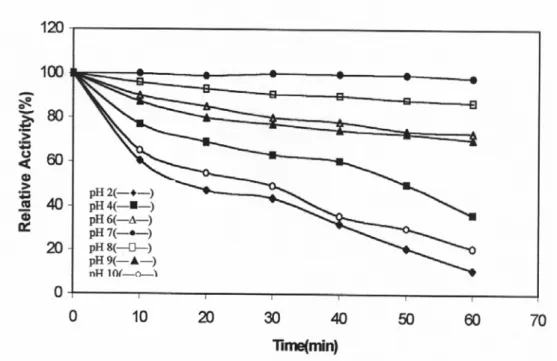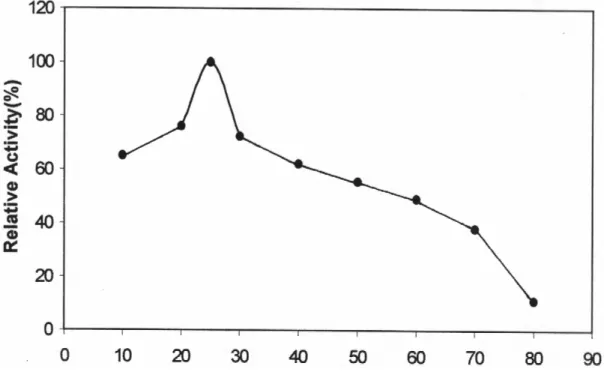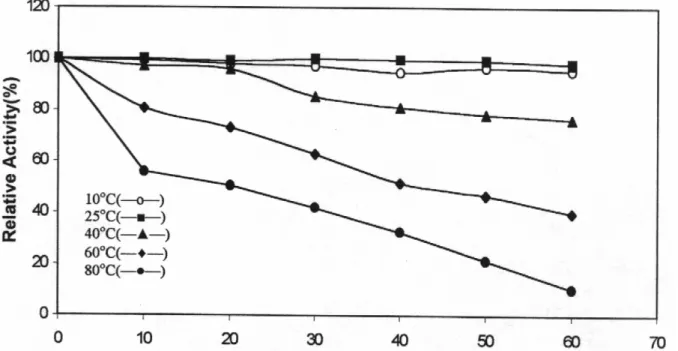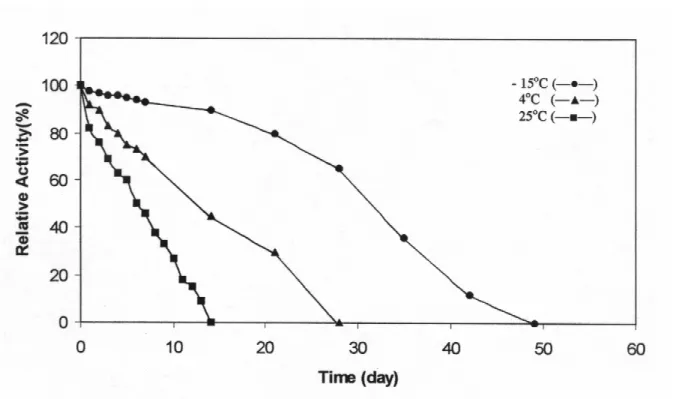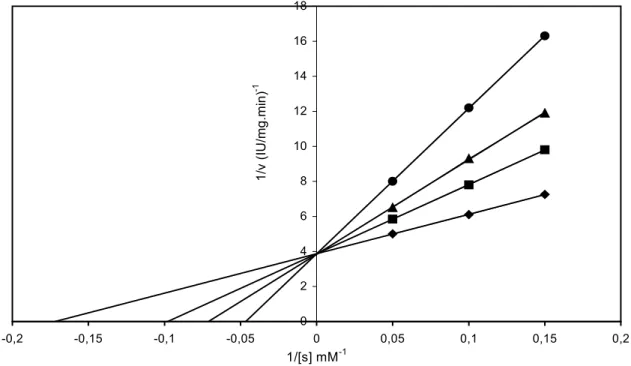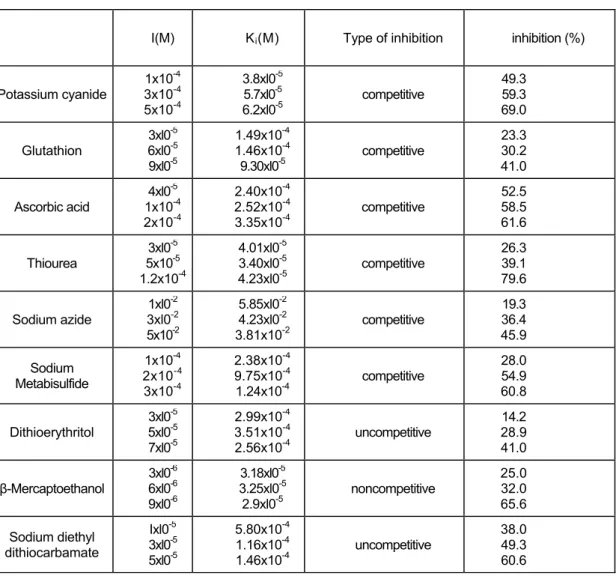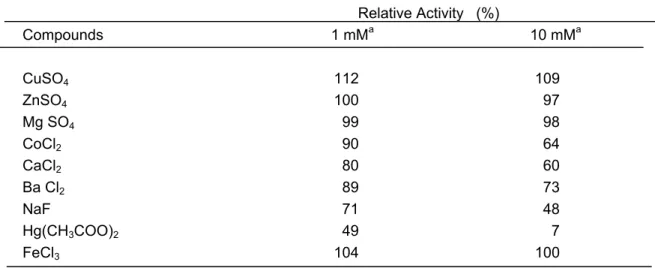Isolation and Characterisation of Polyphenoloxidase from
Jerusalem Artichoke (Helianthus tuberosus)
Tülin AYDEMİR1 - Demet KAVRAYAN1 - Seda ÇINAR1
Abstract: Polyphenol oxidase (PPO) was isolated from Jerusalem artichoke (Helianthus tuberosus).
PPO showed activity to catechol, L-dopa and DL-dopa, but the enzyme had no activity toward L-tyrosine. PH and temperature optima Jerusalem artichoke PPO were 7,0 and 25 °C. The enzyme was significantly stable at neutral pH region. The times required for 50 % inactivation of activity at 60 and 80 °C were found to be 40 and 20 min. respectively. Km and Vmax values were 5.88 mM and 25 402 IU/mg.min with catechol, respectively. Most effective inhibitors was found to be thiourea β-mercaptoethanol and potassium cyanide.
Key Words: Polyphenol oxidase, Jerusalem artichoke (Helianthus tuberosus), characterisation,
isolation, inhibitors.
Özet: Polifenol oksidaz (PPO) enzimi yer elmasından izole edilmiştir. PPO, katekol, L-dopa, DL-dopa ya
karşı aktivite göstermiş fakat bir monofenol olan L-tirozine karşı aktivite göstermemiştir. Yer elmasından izole edilen PPO nun optimum pH ve sıcaklık değeri sırasıyla 7.0 ve 25 °C dir. Enzim nötr pH civarında oldukça kararlıdır. 60 ve 80 °C deki aktivitenin % 50 inaktivasyonu için gerekli olan zaman sırasıyla, 40 ve 20 dakika olarak bulunmuştur. Katekol için Km ve Vmax değerleri sırasıyla, 5.88 mM ve 25 402 IU/mg.min dir. En çok inhibitör etkisi gösteren maddeler potasyum siyanid, β-merkaptoetanol ve tiyoüredir.
Anahtar Kelimeler: Polifenol oksidaz, Yerelması, Helianthus tuberosus, izolasyon.
INTRODUCTION
Enzymatic browning reaction is due to the conversion of phenolic compounds to quinones which undergo polymerization to import brown discoloration. This reaction is an economic problem for processors and consumers. Polyphenol oxidase (PPO; EC 1.14.18.1 also known as phenolase, phenol oxidase, catechol oxidase and tyrosinase ) is a copper enzyme which in the prensence of oxygen catalazes two different reactions. The first reactions is hydroxylation of monophenols to
diphenols (monophenolase activity) and the second reaction is oxidation of diphenols to o-quinones (diphenolase activity) which, in turn, are polymerized to brown, red or black pigments (1).
Polyphenol oxidase has been isolated from many higher plants such as pear (2), grape (3), banana (4), apple (5), apricot (6), plum (7), peach (8), green olive (9), pineapple.
In this work PPO was isolated and characterized from Jerusalem artichoke (Helianthus tuberosus) and substrate and inhibitor effects were also studied.
MATERIALS AND METHODS Plant material
The Jerusalem artichokes (Helianthus tuberosus) were harvested fresh in Menderes region, Turkey.
Reagents
Catechol, L-dopa, DL-dopa, ascorbic acid, sodium metabisulfide, glutathion, thiourea, dithioerythritol, p-mercaptoethanol were purchased from Sigma Chemical Co. (St. Louis USA). Sodium azide, potassium cyanide, sodium diethyl dithiocarbamate, ammonium sulfate, L-tyrosine were purchased from Merck, Germany. All other chemicals used were of analytical grade.
Extraction Procedures
All experimental procedures were carried out at 4 °C. For preparing the crude extract, 50 g of fresh sample was homogenized in 0.05 M phosphate buffer (pH 7.0) containing 0.5 % polyethylene glycol and 10 mM ascorbic acid by using hand blender for 2 min. The crude extract was filtered from two layers of cheesecloth and filtrate was centrifuged at 14000g for 30 min at 4 °C. The supernatant was brought to 60 % (NH4)2SO4 saturation with solid (NH4)2SO4. The precipitated PPO was separated by centrifugation at 14000g for 60 min. It was dissolved in 0.05 M phosphate buffer (pH 7.0) and dialyzed at 4°C in the same buffer for 3 h. The dialyzed solution was used as enzyme source.
Assay of PPO Activity
Enzyme activity was determined with catechol as substrate according to a spectrophotometric procedure (10) The sample cuvette contained 2.9 mL of 0.01 M substrate in 0.05 M phosphate buffer (pH 7.0) and 0.1 mL of the enzyme. The blank sample contained only 3 mL of substrate solution. One unit of PPO activity was defined as the amount of enzyme that caused an increase in absorbance of 0.001/min.
Protein Determination
Protein content was determined according to the dye binding method of Bradford using bovine serum albumin as a standard (11).
pH Optima and pH Stability
PPO activity as a function of pH was determined under standard conditions using various buffers: acetate 0.05 M (pH 3.0-5.0), phosphate 0.05M (pH 5.0-7.0) and Tris-HCl 0.05 M (pH 7.0-10.0). To determine pH stability, the enzyme preincubated in acetate (0.05 M, pH 3.0-5.0), phosphate (0.05 M, pH 5.0-7.0) or Tris-HCl (0.05 M, pH 8.0-9.0) for 60 min at 25°C. Residual PPO activity was assayed 0.01 M catechol as substrate under standard conditions.
Optimum Temperature and Stability
Jerusalem artichoke PPO activity as a function of temperature was determined ranging from 10 to 80 °C. In thermal stability studies, the enzyme solution was incubated at various temperatures for 60 min. and rapidly cooled in an ice bath for 5 min. and the residual activity was assayed 0.01 M catechol as substrate under standard conditions.
Enzyme Kinetics
Maximum velocity (Vmax) and Michaelis-Menten constant (Km) were determined using for catechol, L-dopa, DL-dopa in varying concentrations and in optimum conditions. The reaction was followed in a spectrophotometer and data were plotted according to Lineweaver and Burk (12).
Substrate Specificity
In the studies of substrate specificity, the reaction system consisted of 0.01 mL of the enzyme solution and 2.99 mL of various substrate solution prepared in 0.05 M phosphate buffer, pH 7.0. The increase in absorbance at optimum wavelength for each substrate was measured.
Storage Stability
Storage stability of Jerusalem artichoke was determined of -15, 4, and 25°C catechol as substrate in 0.05 M phosphate buffer (pH 7.0). The activity was determined every day for the first week, and then at per weeks times. PPO samples stored at -15°C were kept in separate vials for each observation to avoid repeated freezethaw effect on the enzyme.
Effect of Inhibitors
To determine the effect of inhibitors on PPO activity, the purified enzyme was preincubated with the various inhibitors for 5 min. at 25 °C. Residual PPO activities was measured under standard assay conditions.
Using five different concentrations of the substrates, PPO activities were measured at these three constant inhibitor concentration with the inhibitors indicated above. Values 1/v and 1/[s] were employed to draw Lineweaver-Burk graphs. Finally Ki constant values were found from the graphs.
PPO activity was measured in the presence (final concentration 1.0 mM or 10.0 mM) and absence of various ionic compounds under the standard conditions.
RESULTS AND DISCUSSION Optimum pH and Stability
PPO activity as a function of pH was determined using catechol, dopa, Ddopa and L-tyrosine as substrates. Jerusalem artichoke PPO had an optimum pH of 7.0 using catechol as substrate (Figure 1). Maximum activity with L-dopa and DL-dopa was obtained at pH 8.0. The optimum pH for PPO activity has been found to vary with source of the enzyme and substrate in a relatively wide range of pH (13). In general most fruit showed maximum activities at on near neutral pH values. (14). Halim and Montgomery and Zhou who reported a pH optimum pH 7.0 for d'Anjou and Yali pear PPO but in contrast Siddiq was reported no activity at pH 7.0 for red pear (15, 16, 7).
Fig. 1: Effect of pH on Jerusalem artichoke PPO activity.
The effect of pH on stability was also determined. The enzyme was significantly stable in the neutral pH region (Figure 2). But 40 and 43 % of the initial activity were lost at pH 4.0 and 9.0. Benjamin and Montgomery, reported that polyphenol oxidases involved in fruits are stable between weak acid pH and neutral pH (17).
Optimum Temperature and Heat Stability
The activity of PPO was measured at different temperatures at pH 7.0 for 5 min. The enzyme showed the highest activity at 40 °C (Figure 3). This value was different from those of Amasya apple [18 °C, (18)], grape [25 °C, (19)] and Stanley plums [20 °C, (7)] using catechol as substrate.
Fig. 3: Effect of temperature on Jerusalem artichoke PPO activity.
Jerusalem artichoke PPO was found to be most stable at 25°C. Heating for 60 min at 40°C did not cause a significant loss of enzymatic activity. The times required for %50 inactivation of activity at 60 and 80°C were found to be 40 and 20 min. respectively. (Figure 4). It has been reported that Stanley plum and Allium sp. PPO were stable at 70 °C for 30 min and at 40 °C for 30 min. respectively. (7, 20). It has been noted that heat stability of the enzyme may be related to ripeness of fruit, and some cases it is also dependent on pH.
Fig. 4: Thermal inactivation of Jerusalem artichoke PPO at different temperatures.
Enzyme Kinetics
Km and Vmax values observed with different substrates was shown in Table 1. The Km values for Jerusalem artichoke PPO were determined to be 5.88 mM for catechol, 7.50 mM for DL-dopa and 8.80 mM for L-dopa. According to the resoults the Vmax values for catechol is higher than values for DL-dopa and L-DL-dopa (Table 1).
Rivas and Whitaker reported a Km of 8.0 mM, with 4-methylcatechol for Barlett pear PPO (21). A significantly lower Km of 1.5 mM, with chlorogenic acid, has been reported for Yali pear PPO by Zhou and Feng (14).
TABLE 1: Optimum pH, Temperature, Km and Vmax Values of the PPO for Different Substrat Substrat Optimum pH Optimum temp.(0C) Km(M) Vmax (IU/mg-min)
Catechol 7.0 25 5.88xl0-3 25402
D-L dopa 8.0 40 7.50xl0-3 17420
L-dopa 8.0 45 8.80xl0-3 14512
Substrat Specificity
Table 1 shows substrate specifity of Jerusalem artichoke PPO. To determine substrate specifity, o-dihydroxyphenols and monohydroxyphenolic compounds were tested. The enzyme was active towards the o-diphenolic compounds. Maximum activity was detected toward catechol
followed by DL-dopa and L-dopa. The enzyme had no activity toward L-tyrosine (monohydroxy). The PPO extracted from different sources has been shown to have varying substrate specificity as reported by Wong et al (10). These results are similar to those reported by Halim and Montgomery Zhou and Feng for d'Anjou pear and Yali pear PPO respectively, (15, 14).
Fig. 5: Storage stability of Jerusalem artichoke PPO activity.
Storage Stability
Effect of different storage temperatures on partially purified Jerusalem artichoke PPO was investigated. The enzyme was observed rather stable at -15°C. It lost only % 5 activity on storage 7 days and the enzyme was completely lost its activity after 7 weeks. At 4°C %30 loss in PPO activity was observed during first week and completely inactivation after 4 weeks (Figure 5).
Effect of Inhibitors
Table 2 shows Ki values the percentages of inhibition obtained with various compounds as inhibitors using catechol as substrate for Jerusalem artichoke PPO. Lineweaver-Burk plots of 1/v versus 1/[s] at three inhibitor concentrations determined the type of inhibition. Figure 6 is given as an example of Lineweaver-Burk plots to determined inhibition type. Noncompetitive inhibition of PPO was obtained with β-mercaptoethanol. The inhibition of Jerusalem artichoke PPO with sodium diethyl dithiocarbamate and dithioerythritol were uncompetitive and the others were competitive. I50values obtained with various compounds as inhibitors using catechol as substrate. The values were 4.7x10-4 M, l.19xl0-4 M, 2.0.xl0-5 M, 6.85xl0-5 M, 5.4x10-2 M, 2.3x10-4 M, 8.2xl0-5 M, 6.5x10-6 M, 3.0x10-5 M for
potassium cyanide, glutathion, ascorbic acid, thiourea, sodium azide, sodium metabisulfide, dithioerythritol, β-mercaptoethanol, sodium diethyl dithiocarbamate respectively.
Fig. 6: Lineweaver-Burk plot for the inhibition of PPO activity with thiourea.
Thiourea, β-mercaptoethanol and potassium cyanide were found to be the most effective inhibitors of browning by Jerusalem artichoke PPO. Since PPO contains copper as a co-factor, the irreversible inactivation of this enzyme can be attaced by substances (such as thiol compounds-thiourea, 8-hydroxyquinoline, etc.) which remove copper from the active site of the enzyme (22). The enzyme also seemed to be sensitive to ascorbic acid and β-mercaptoethanol. Ascorbate reduces the initial quinone formed by the enzyme to the original diphenol, before it undergoes secondary reactions which lead to browning (23). Golan-Goldhirsh and Whitaker have reported ascorbic acid to cause irreversible inhibition of mushroom PPO, (24).
0 2 4 6 8 10 12 14 16 18 -0,2 -0,15 -0,1 -0,05 0 0,05 0,1 0,15 0,2 1/[s] mM-1 1/v (IU /mg.mi n) -1
TABLE 2: Ki Values and inhibition modes of the PPO with different inhibitors
I(M) Ki(M) Type of inhibition inhibition (%)
Potassium cyanide 1x10 -4 3x10-4 5x10-4 3.8xl0-5 5.7xl0-5 6.2xl0-5 competitive 49.3 59.3 69.0 Glutathion 3xl0-5 6xl0-5 9xl0-5 1.49x10-4 1.46x10-4 9.30xl0-5 competitive 23.3 30.2 41.0 Ascorbic acid 4xl0-5 1x10-4 2x10-4 2.40x10-4 2.52x10-4 3.35x10-4 competitive 52.5 58.5 61.6 Thiourea 3xl0 -5 5x10-5 1.2x10-4 4.01xl0-5 3.40xl0-5 4.23xl0-5 competitive 26.3 39.1 79.6 Sodium azide 1xl0-2 3xl0-2 5x10-2 5.85xl0-2 4.23xl0-2 3.81x10-2 competitive 19.3 36.4 45.9 Sodium Metabisulfide 1x10-4 2x10-4 3x10-4 2.38x10-4 9.75x10-4 1.24x10-4 competitive 28.0 54.9 60.8 Dithioerythritol 3xl0-5 5xl0-5 7xl0-5 2.99x10-4 3.51x10-4 2.56x10-4 uncompetitive 14.2 28.9 41.0 β-Mercaptoethanol 3xl0-6 6xl0-6 9xl0-6 3.18xl0-5 3.25xl0-5 2.9xl0-5 noncompetitive 25.0 32.0 65.6 Sodium diethyl dithiocarbamate Ixl0-5 3xl0-5 5xl0-5 5.80x10-4 1.16x10-4 1.46x10-4 uncompetitive 38.0 49.3 60.6
The effects of various ions on the partialy purified enzyme activity are listed in Table 3. Cu++ and Fe+++ ions activated the oxidation of PPO at 1 mM. Similar PPO activation by Cu++ and Fe+++ ions were reported by same researches (25, 26). Metal ions Ba++, Co++, Ca++ were poor inhibitors for the enzyme at 1mM concentration, similary results were reported for Satsuma mandarin and cabbage at the same concentrations (27, 28). The enzyme was markedly inhibited by Hg(CH3COO)2 and NaF at 10 mM.
Table 3: Effect of various compounds on the activity of PPO from Jerusalem artichoke. Relative Activity (%) Compounds 1 mMa 10 mMa CuSO4 112 109 ZnSO4 100 97 Mg SO4 99 98 CoCl2 90 64 CaCl2 80 60 Ba Cl2 89 73 NaF 71 48 Hg(CH3COO)2 49 7 FeCl3 104 100
REFERENCES
1 Garcia-Carmona, F., Valero, E., Cabanes, J., Effects of L-proline on mushroom tyrosinase.
Phytochemistry, 27, 1961-1964, 1988.
2 Siddiq, M, Cash, J. N., Sinha, N. K. and Akhter, P., Characterization and inhibition of PPO from pears (Pyrus
communis L. ev Bose and Red) J. Biochem 17, 327-331, 1994.
3 Mayer, A. M. and Harel, E., Polyphenol oxidase in plants. Phytochemistry 18, 193-215, 1979.
4 Palmer, J. K., Banana polyphenol oxidase; preparation and properties. PlantPhysiol. 38, 508-514, 1963. 5 Janovitz-Klapp, A. Richard, F. and Nicolas J., Polyphenol oxidase from apple purification and some properties.
Phytochemistry 28, 2903-2907, 1989
6 Dijkstra, L. and Walker, J. R. L., Enzymic Browning in Apricots (Prunus armeniace) J. Sci. Food Agric., 229-234, 1990
7 Siddiq, M., Sinha, N. K., Cash, J. N., Characterisation of a polyphenol oxidase from stanley plums. J. Food. Sci. 57, 1177-1185, 1992
8 Flurkey,W. H. and Jen, J. J., Purification of peach polyphenol oxidase concentrations in relation to degree of
browning.J. Food Biochem. 4, 29-41, 1980.
9 Ben-Shalom, N. Kahn, V., Harel, E., Mayer, A. W., Catechol oxidase from green olives: properties and partial
purification. Phytochemistry, 16, 1153-1157, 1977.
10 Wong, T. C., Luh, B. S., Whitaker, J. R, Isolation and characterization of polyphenol oxidase isozymes of
cling stone peach Plantphysiol. 48, 19-25, 1971
11 Bradford, M. M., A rapid and sensitive method for the quantification of microgram quantities of protein
utulizing the priciple of protein-dye binding. Anal. Biochem. 72, 248-255, 1976
12 Lineweaver, H. and Burk, D., The determination of enzyme dissociation constants. J. Amer. Chem.Soc. 56, 658-665, 1934
13 Aylward, F., Haisman, D. R. Oxidation systems in fruits and vegetables- Their relation to the quality of
presured products. Adv. FoodRes., 17, l-8, 1969.
14 Zhou, H. and Feng, V., Polyphenol oxidase from Yali pears (pyrus bret schneideri). J. Sci. FoodAgric. 57, 307-314, 1991
15 Halim, D.H. and Montgomery, M.W., Polyphenol oxidase of d’Anjou pears (Pyrus communis L.). J. Food Sci. 43, 603-610, 1978
16 Zhou, H., Feng, X., Polyphenol oxidase from Yali pear (Pyrus-bretschneideri), J. Sci. Food Agric 57, 307-315, 1991 17 Benjamin, N. D. and Montgomery, M. W., Polyphenol oxidase of royal an cherries: purification and
characterization. J.Food Sci.38, 799-804, 1973.
18 Oktay, M.; Kufrevioglu, 6. 1.; Kocacalıskan, L. and Sakiroglu, H., Polyphenol oxidase from amasya apple. J.
Food Sci. 60, 495-500, 1995.
19 Wisseman, K. W., Lee, C. Y., Characterization of polyphenol oxidase from Ravat 51 and Niagora grapes. J. Food Sci. 46, 506-508, 1981.
20 Arslan, O., Temur, A., Tozlu, I., Polyphenol oxidase from Allium sp. J. Agric Food. Chem. 45, 2861-2863, 1997. 21 Rivas, N. J. and Whitaker, Purification and some properties of two polyphenol oxidase from bartlett pears.
J.R, Plantphys. 52, 501-510, 1973.
22 Schwimmer, S., In source Book of Food Enzymology; AVI Publishing, 267-274, 1981
23 Matheis, G.and Whitaker, J. R., Modification of proteins by polyphenol oxidase and peroxidase and their
products. J Food Biochem. 8, 137-143, 1984
24 Golan-Goldhirsh, A. and Whitaker, J. R., Effect of ascorbic acid, sodium bisulfite and thiol compounds on
mushroom polyphenol oxidase. J Agric Food Chem. 32, 1003-1008, 1984.
25 Simpson, B.K., Marshall,M.R., and Otwell, S., Phenol oxidase from Srimp ( penaeus setifems):
Purification and some properties J. Agric. Food Chem., 39, 918-926, 1987.
26 Leoni, O., Palmeri, S., Lattanzio, V., and Van, Sumere, C.F., Polyphenol oxidase from Artichoke (Cyanara
scolymus L.) Food Chem., 38, 27-39, 1990.
27 Fujita, S., and Tono, T., Purification of pyrogalloloxidase and phloroglucinol oxidase from satsuma
mandarin fruits and their properties. Nippon Noseikasaku Kaishi, 53, 233-240, 1979.
28 Fujita, S., Saari, N.B., Maegawa, M., Tetsuka, T., Hayashi, N., and Tono, T., Purification and properties of
